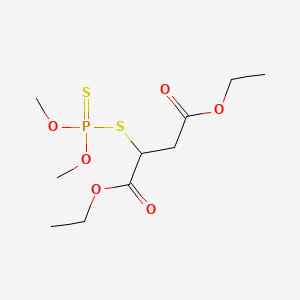Attribution Statement: LactMed is a registered trademark of the U.S. Department of Health and Human Services.
NCBI Bookshelf. A service of the National Library of Medicine, National Institutes of Health.
Drugs and Lactation Database (LactMed®) [Internet]. Bethesda (MD): National Institute of Child Health and Human Development; 2006-.
CASRN: 121-75-5

Drug Levels and Effects
Summary of Use during Lactation
Malathion appears to be poorly absorbed after topical application, so it is not likely to reach the breastmilk in large amounts. However, breastmilk excretion of malathion has not been studied after application of the 0.5% lotion. Until more data become available, an alternate agent is preferred.[1]
Drug Levels
The manufacturer reports that 8% of a topically applied solution of malathion (concentration unspecified) in an acetone vehicle is absorbed through human skin. However, the extent of absorption from commercial 0.5% malathion lotion is not known.
Maternal Levels. Nine breastmilk samples were analyzed from women who lived in an area of California that had been sprayed in 1981 with malathion from 4 to 14 times during their pregnancy and lactation. Malathion was undetectable (<5 mcg/L) in all of the samples. Any exposure of the women would probably have been via inhalation or direct ingestion.[2]
Twelve donors from Bhopal, India provided hindmilk samples to monitor for malathion. The mean malathion level in the samples was 0.043 mg/L (range 0 to 0.086 mg/L). The calculated daily intake by breastfed infants was 40% higher than the World Health Organization recommended average daily intake. The source of malathion was thought to be from contaminated food crops that had been harvested before the recommended waiting time after spraying.[3]
Infant Levels. Relevant published information was not found as of the revision date.
Effects in Breastfed Infants
Relevant published information was not found as of the revision date.
Effects on Lactation and Breastmilk
Relevant published information was not found as of the revision date.
Alternate Drugs to Consider
References
- 1.
- Butler DC, Heller MM, Murase JE. Safety of dermatologic medications in pregnancy and lactation: Part II. Lactation. J Am Acad Dermatol 2014;70:417.e1-10. [PubMed: 24528912]
- 2.
- Lönnerdal B, Asquith MT. Malathion not detected in breast milk of women living in aerial spraying areas. N Engl J Med 1982;307:439. Letter. [PubMed: 7088119]
- 3.
- Sanghi R, Pillai MK, Jayalekshmi TR, Nair A. Organochlorine and organophosphorus pesticide residues in breast milk from Bhopal, Madhya Pradesh, India. Hum Exp Toxicol 2003;22:73-6. [PubMed: 12693830]
Substance Identification
Substance Name
Malathion
CAS Registry Number
121-75-5
Disclaimer: Information presented in this database is not meant as a substitute for professional judgment. You should consult your healthcare provider for breastfeeding advice related to your particular situation. The U.S. government does not warrant or assume any liability or responsibility for the accuracy or completeness of the information on this Site.
- User and Medical Advice Disclaimer
- Drugs and Lactation Database (LactMed) - Record Format
- LactMed - Database Creation and Peer Review Process
- Fact Sheet. Drugs and Lactation Database (LactMed)
- Drugs and Lactation Database (LactMed) - Glossary
- LactMed Selected References
- Drugs and Lactation Database (LactMed) - About Dietary Supplements
- Breastfeeding Links
- PubChem SubstanceRelated PubChem Substances
- PubMedLinks to PubMed
- Microencapsulated organophosphorous insecticides. III. Some aspects on the volatilization of malathion and disulfoton from aqueous suspensions of microcapsules.[J Microencapsul. 1987]Microencapsulated organophosphorous insecticides. III. Some aspects on the volatilization of malathion and disulfoton from aqueous suspensions of microcapsules.Drăgan D, Carpov A. J Microencapsul. 1987 Apr-Jun; 4(2):97-105.
- Review Dimethyl Fumarate.[Drugs and Lactation Database (...]Review Dimethyl Fumarate.. Drugs and Lactation Database (LactMed®). 2006
- Identification of metabolites of malathion in plant, water and soil by GC-MS.[Biomed Chromatogr. 1997]Identification of metabolites of malathion in plant, water and soil by GC-MS.Kaur I, Mathur RP, Tandon SN, Dureja P. Biomed Chromatogr. 1997 Nov-Dec; 11(6):352-5.
- Gas chromatographic-mass spectrometric characterization of an alteration product of malathion detected in stored rice.[J Assoc Off Anal Chem. 1981]Gas chromatographic-mass spectrometric characterization of an alteration product of malathion detected in stored rice.Hansen LB, Castillo GD, Biehl ER. J Assoc Off Anal Chem. 1981 Sep; 64(5):1232-7.
- Review Benzocaine.[Drugs and Lactation Database (...]Review Benzocaine.. Drugs and Lactation Database (LactMed®). 2006
- Malathion - Drugs and Lactation Database (LactMed®)Malathion - Drugs and Lactation Database (LactMed®)
Your browsing activity is empty.
Activity recording is turned off.
See more...
